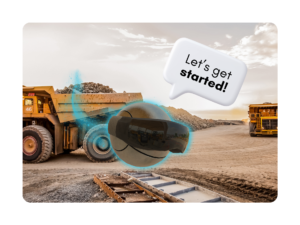
VR, AR and MR training empowers your employees to learn and explore beyond the constraints of the real world.

Elevate workforce training with custom PC applications tailored to deliver precise, immersive, and scalable learning solutions for diverse industries.

Capture insight on your team's progress in virtual training and what strengths or struggles your members may have

Harnessing a virtual copy of your business allows for a 1:1 digital environment for planning, optimizing or immersive virtual training
By circumventing the need for physically available equipment or training material our programs can bring your company's training costs down.
Equip your employees with the skills and experience they need to get started without having to pull from an experienced team member's heavy schedule.
Virtual and mixed reality training are state-of-the-art solutions to the question of, "how do we make the work engaging and interesting."
Practice safe and repeatable modules that allow you to try, fail and succeed in a risk free environment

Enhance your XR application with custom input devices tailored to your unique needs, offering greater precision, intuitive controls, and an immersive user experience that standard controllers simply can’t match.

Bring your XR application to life with stunning VFX and realistic simulations, delivering unparalleled visual impact and interactive depth to captivate your audience and elevate user engagement.

Elevate realism in your XR application with photogrammetry and photoscanned objects, offering hyper-detailed, true-to-life assets that immerse users in visually stunning environments.

Immerse your users in breathtaking realism with photoscanned environments, capturing every detail of real-world locations to create lifelike, engaging XR experiences.

Enhance user interaction with animated virtual assistants, delivering personalized guidance, dynamic engagement, and a human touch to your XR application.
Participants can learn at their own pace, allowing them to spend more time on challenging topics and less on familiar ones. Training materials can be accessed from any location with internet access, making it simple to remotely train.
There is no need for participants to travel to a central training location, which can save on travel, accommodation, and meal expenses. Digital materials can be updated and distributed easily, eliminating the need for printed handouts and physical resources.
Every participant is able to receive the exact same training content, ensuring consistency in the information delivered. Training programs can be quickly updated to reflect new information, ensuring that all participants have access to the most current material.
PC training programs can include multimedia elements such as videos, simulations, quizzes, and interactive exercises to enhance engagement and retention. Participants can receive instant feedback on quizzes and assessments, helping them identify areas for improvement right away.

Bring your training to life with breathtaking VFX and realistic simulations. Learn faster, engage deeper, and experience immersive scenarios.

Integrate custom photo-scanned objects to provide trainees with highly accurate, interactive models that closely replicate real-world tools and equipment.

Provide employees with a seamless transition from virtual training to real-world applications by simulating actual work environments with precision.

Improve the accessibility and efficiency of training programs with a responsive, animated virtual assistant designed to support learners at every step.
The dashboard provides insights into trainees' interactions with the virtual environment, including completion rates, time spent on tasks, and performance metrics such as accuracy and proficiency.
Analyzing training data allows organizations to identify strengths and weaknesses in their training programs, refine instructional content, and tailor training experiences to better meet the needs of individual learners or specific training objectives.
By analyzing data on learners' progress, preferences, and performance, trainers can adapt content delivery, pacing, and difficulty levels to match each learner's needs and learning style.
By analyzing historical data and trends, organizations can anticipate potential challenges, identify emerging needs, and proactively adjust their training strategies to align with evolving requirements.
By integrating real-time data from sensors, IoT devices, and other sources, companies gain comprehensive insights into their operations. This visibility allows for better monitoring of performance, identification of inefficiencies, and predictive analysis of potential issues.
By simulating different scenarios and assessing their potential impact, decision-makers can evaluate alternative strategies, anticipate outcomes, and make informed choices.
By simulating new concepts, designs, or technologies in a virtual environment, companies can test ideas, iterate quickly, and validate hypotheses before investing in physical prototypes or implementations.
Predictive maintenance based on digitally mapped data helps prevent unplanned downtime, extend asset lifespan, and reduce maintenance costs.
© 2024 VR Acquisition Holdings, LLC